
Concept explainers
(a)
Interpretation:Whether the pair of two molecules representconstitutional isomers, enantiomers, diastereomers, or identical isomers should be identified.
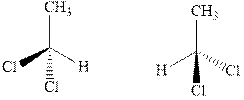
Concept introduction:In order to assign absolute configuration of R and S, Cahn − Ingold − Prelog rules are used and the first step is to assign the priority order on the basis of
If the groups now are arranged are read from highest towards least in clockwise fashion then R is assigned to the stereocenter if the rotation is anticlockwise then S is assigned at the configuration.
Fischer projection is written along with the priorities assigned and groups are interchanged between adjacent places so as to obtain the lowest priority group at the bottom or lowest priority.
(b)
Interpretation: Whether the pair of two molecules represent constitutional isomers, enantiomers, diastereomers, or identical isomers should be identified.

Concept introductionIn order to assign absolute configuration of R and S, Cahn − Ingold − Prelog rules are used and the first step is to assign the priority order on the basis of atomic number. The one with highest atomic number gest highest priority and is designated as 1 and so on and with the lowest priority group at the bottom.
If the groups now are arranged are read from highest towards least in clockwise fashion then R is assigned to the stereocenter if the rotation is anticlockwise then S is assigned at the configuration.
Fischer projection is written along with the priorities assigned and groups are interchanged between adjacent places so as to obtain the lowest priority group at the bottom or lowest priority.
(c)
Interpretation: Whether the pair of two molecules represent constitutional isomers, enantiomers, diastereomers, or identical isomers should be identified.

Concept introduction:In order to assign absolute configuration of R and S, Cahn − Ingold − Prelog rules are used and the first step is to assign the priority order on the basis of atomic number. The one with highest atomic number gest highest priority and is designated as 1 and so on and with the lowest priority group at the bottom.
If the groups now are arranged are read from highest towards least in clockwise fashion then R is assigned to the stereocenter if the rotation is anticlockwise then S is assigned at the configuration.
Fischer projection is written along with the priorities assigned and groups are interchanged between adjacent places so as to obtain the lowest priority group at the bottom or lowest priority.
(d)
Interpretation: Whether the pair of two molecules represent constitutional isomers, enantiomers, diastereomers, or identical isomers should be identified.
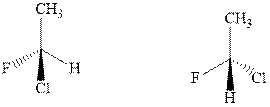
Concept introduction:In order to assign absolute configuration of R and S, Cahn − Ingold − Prelog rules are used and the first step is to assign the priority order on the basis of atomic number. The one with highest atomic number gest highest priority and is designated as 1 and so on and with the lowest priority group at the bottom.
If the groups now are arranged are read from highest towards least in clockwise fashion then R is assigned to the stereocenter if the rotation is anticlockwise then S is assigned at the configuration.
Fischer projection is written along with the priorities assigned and groups are interchanged between adjacent places so as to obtain the lowest priority group at the bottom or lowest priority.
(e)
Interpretation: Whether the pair of two molecules represent constitutional isomers, enantiomers, diastereomers, or identical isomers should be identified.

Concept introduction:In order to assign absolute configuration of R and S, Cahn − Ingold − Prelog rules are used and the first step is to assign the priority order on the basis of atomic number. The one with highest atomic number gest highest priority and is designated as 1 and so on and with the lowest priority group at the bottom.
If the groups now are arranged are read from highest towards least in clockwise fashion then R is assigned to the stereocenter if the rotation is anticlockwise then S is assigned at the configuration.
Fischer projection is written along with the priorities assigned and groups are interchanged between adjacent places so as to obtain the lowest priority group at the bottom or lowest priority.
(f)
Interpretation: Whether the pair of two molecules represent constitutional isomers, enantiomers, diastereomers, or identical isomers should be identified.

Concept introduction:The enantiomers are identical chemical compounds that have a mirror-image relationship to each other while diastereomers do not hold mirror image relationships. The former are chiral and optically active while the latter can be chiral or achiral.
(g)
Interpretation: Whether the pair of two molecules represent constitutional isomers, enantiomers, diastereomers, or identical isomers should be identified.
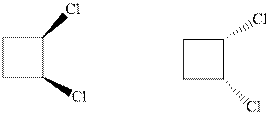
Concept introduction:In order to assign absolute configuration of R and S, Cahn − Ingold − Prelog rules are used and the first step is to assign the priority order on the basis of atomic number. The one with highest atomic number gest highest priority and is designated as 1 and so on and with the lowest priority group at the bottom.
If the groups now are arranged are read from highest towards least in clockwise fashion then R is assigned to the stereocenter if the rotation is anticlockwise then S is assigned at the configuration.
Fischer projection is written along with the priorities assigned and groups are interchanged between adjacent places so as to obtain the lowest priority group at the bottom or lowest priority.
(h)
Interpretation: Whether the pair of two molecules represent constitutional isomers, enantiomers, diastereomers, or identical isomers should be identified.
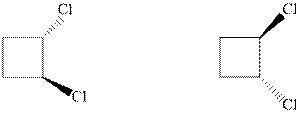
Concept introduction:In order to assign absolute configuration of R and S, Cahn − Ingold − Prelog rules are used and the first step is to assign the priority order on the basis of atomic number. The one with highest atomic number gest highest priority and is designated as 1 and so on and with the lowest priority group at the bottom.
If the groups now are arranged are read from highest towards least in clockwise fashion then R is assigned to the stereocenter if the rotation is anticlockwise then S is assigned at the configuration.
Fischer projection is written along with the priorities assigned and groups are interchanged between adjacent places so as to obtain the lowest priority group at the bottom or lowest priority.
(i)
Interpretation: Whether the pair of two molecules represent constitutional isomers, enantiomers, diastereomers, or identical isomers should be identified.
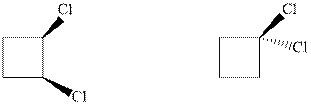
Concept introduction:In order to assign absolute configuration of R and S, Cahn − Ingold − Prelog rules are used and the first step is to assign the priority order on the basis of atomic number. The one with highest atomic number gest highest priority and is designated as 1 and so on and with the lowest priority group at the bottom.
If the groups now are arranged are read from highest towards least in clockwise fashion then R is assigned to the stereocenter if the rotation is anticlockwise then S is assigned at the configuration.
Fischer projection is written along with the priorities assigned and groups are interchanged between adjacent places so as to obtain the lowest priority group at the bottom or lowest priority.
(j)
Interpretation: Whether the pair of two molecules represent constitutional isomers, enantiomers, diastereomers, or identical isomers should be identified.
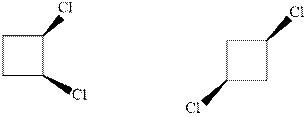
Concept introduction:In order to assign absolute configuration of R and S, Cahn − Ingold − Prelog rules are used and the first step is to assign the priority order on the basis of atomic number. The one with highest atomic number gest highest priority and is designated as 1 and so on and with the lowest priority group at the bottom.
If the groups now are arranged are read from highest towards least in clockwise fashion then R is assigned to the stereocenter if the rotation is anticlockwise then S is assigned at the configuration.
Fischer projection is written along with the priorities assigned and groups are interchanged between adjacent places so as to obtain the lowest priority group at the bottom or lowest priority.
(k)
Interpretation: Whether the pair of two molecules represent constitutional isomers, enantiomers, diastereomers, or identical isomers should be identified.
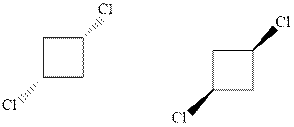
Concept introduction:In order to assign absolute configuration of R and S, Cahn − Ingold − Prelog rules are used and the first step is to assign the priority order on the basis of atomic number. The one with highest atomic number gest highest priority and is designated as 1 and so on and with the lowest priority group at the bottom.
If the groups now are arranged are read from highest towards least in clockwise fashion then R is assigned to the stereocenter if the rotation is anticlockwise then S is assigned at the configuration.
Fischer projection is written along with the priorities assigned and groups are interchanged between adjacent places so as to obtain the lowest priority group at the bottom or lowest priority.
(l)
Interpretation: Whether the pair of two molecules represent constitutional isomers, enantiomers, diastereomers, or identical isomers should be identified.
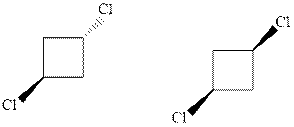
Concept introduction:In order to assign absolute configuration of R and S, Cahn − Ingold − Prelog rules are used and the first step is to assign the priority order on the basis of atomic number. The one with highest atomic number gest highest priority and is designated as 1 and so on and with the lowest priority group at the bottom.
If the groups now are arranged are read from highest towards least in clockwise fashion then R is assigned to the stereocenter if the rotation is anticlockwise then S is assigned at the configuration.
Fischer projection is written along with the priorities assigned and groups are interchanged between adjacent places so as to obtain the lowest priority group at the bottom or lowest priority.
(m)
Interpretation: Whether the pair of two molecules represent constitutional isomers, enantiomers, diastereomers, or identical isomers should be identified.

Concept introduction:The enantiomers are identical chemical compounds that have a mirror-image relationship to each other while diastereomers do not hold mirror image relationships. The former are chiral and optically active while the latter can be chiral or achiral.
(n)
Interpretation: Whether the pair of two molecules represent constitutional isomers, enantiomers, diastereomers, or identical isomers should be identified.

Concept introduction: The enantiomers are identical chemical compounds that have a mirror-image relationship to each other while diastereomers do not hold mirror image relationships. The former are chiral and optically active while the latter can be chiral or achiral.
(o)
Interpretation: Whether the pair of two molecules represent constitutional isomers, enantiomers, diastereomers, or identical isomers should be identified.

Concept introduction:In order to assign absolute configuration of R and S, Cahn − Ingold − Prelog rules are used and the first step is to assign the priority order on the basis of atomic number. The one with highest atomic number gest highest priority and is designated as 1 and so on and with the lowest priority group at the bottom.
If the groups now are arranged are read from highest towards least in clockwise fashion then R is assigned to the stereocenter if the rotation is anticlockwise then S is assigned at the configuration.
Fischer projection is written along with the priorities assigned and groups are interchanged between adjacent places so as to obtain the lowest priority group at the bottom or lowest priority.
The enantiomers are identical chemical compounds that have a mirror-image relationship to each other while diastereomers do not hold mirror image relationships. The former are chiral and optically active while the latter can be chiral or achiral.
(p)
Interpretation: Whether the pair of two molecules represent constitutional isomers, enantiomers, diastereomers, or identical isomers should be identified.
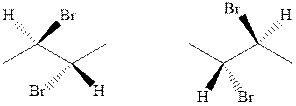
Concept introduction:In order to assign absolute configuration of R and S, Cahn − Ingold − Prelog rules are used and the first step is to assign the priority order on the basis of atomic number. The one with highest atomic number gest highest priority and is designated as 1 and so on and with the lowest priority group at the bottom.
If the groups now are arranged are read from highest towards least in clockwise fashion then R is assigned to the stereocenter if the rotation is anticlockwise then S is assigned at the configuration.
Fischer projection is written along with the priorities assigned and groups are interchanged between adjacent places so as to obtain the lowest priority group at the bottom or lowest priority.
Want to see the full answer?
Check out a sample textbook solution
Chapter 5 Solutions
ORGANIC CHEMISTRY (LL)-PACKAGE
- Indicate the substitutes in one place, if they are a diazonio room.arrow_forwardIndicate the product formed in each reaction. If the product exhibits tautomerism, draw the tautomeric structure. a) о + CH3-NH-NH2 CO2C2H5 b) + CoH5-NH-NH2 OC2H5arrow_forwardIndicate the formula of the compound, that is the result of the N- alquilación (nucleofílic substitution), in which an additional lateral chain was formed (NH-CH2-COOMe). F3C. CF3 NH NH2 Br о OMe K2CO3, DABCO, DMFarrow_forward
- Synthesis of 1-metilbenzotriazole from 1,2-diaminobenceno.arrow_forwardSynthesis of 1-metilbenzotriazole.arrow_forwardIndicate the formula of the compound, that is the result of the N- alquilación (nucleofílic substitution), in which an additional lateral chain was formed (NH-CH2-COOMe). F3C. CF3 NH NH2 Br о OMe K2CO3, DABCO, DMFarrow_forward
- Identify the mechanism through which the following reaction will proceed and draw the major product. Part 1 of 2 Br KOH EtOH Through which mechanism will the reaction proceed? Select the single best answer. E1 E2 neither Part: 1/2 Part 2 of 2 Draw the major product formed as a result of the reaction. Click and drag to start drawing a structure. Xarrow_forwardWhat is single-point calibration? Provide an example.arrow_forwardDraw the major product formed via an E1 pathway.arrow_forward
- Part 9 of 9 Consider the products for the reaction. Identify the major and minor products. HO Cl The E stereoisomer is the major product and the Z stereoisomer is the minor product ▼ S major product minor productarrow_forwardConsider the reactants below. Answer the following questions about the reaction mechanism and products. HO Clarrow_forwardjulietteyep@gmail.com X YSCU Grades for Juliette L Turner: Orc X 199 A ALEKS - Juliette Turner - Modul X A ALEKS - Juliette Turner - Modul x G butane newman projection - Gox + www-awa.aleks.com/alekscgi/x/Isl.exe/10_u-IgNslkr7j8P3jH-IBxzaplnN4HsoQggFsejpgqKoyrQrB2dKVAN-BcZvcye0LYa6eXZ8d4vVr8Nc1GZqko5mtw-d1MkNcNzzwZsLf2Tu9_V817y?10Bw7QYjlb il Scribbr citation APA SCU email Student Portal | Main Ryker-Learning WCU-PHARM D MySCU YSCU Canvas- SCU Module 4: Homework (Ch 9-10) Question 28 of 30 (1 point) | Question Attempt: 1 of Unlimited H₂SO heat OH The mechanism of this reaction involves two carbocation intermediates, A and B. Part 1 of 2 KHSO 4 rearrangement A heat B H₂O 2 OH Draw the structure of A. Check Search #t m Save For Later Juliet Submit Assignm 2025 McGraw Hill LLC. All Rights Reserved. Terms of Use | Privacy Center | Accessarrow_forward
 Organic Chemistry: A Guided InquiryChemistryISBN:9780618974122Author:Andrei StraumanisPublisher:Cengage Learning
Organic Chemistry: A Guided InquiryChemistryISBN:9780618974122Author:Andrei StraumanisPublisher:Cengage Learning General, Organic, and Biological ChemistryChemistryISBN:9781285853918Author:H. Stephen StokerPublisher:Cengage Learning
General, Organic, and Biological ChemistryChemistryISBN:9781285853918Author:H. Stephen StokerPublisher:Cengage Learning Organic And Biological ChemistryChemistryISBN:9781305081079Author:STOKER, H. Stephen (howard Stephen)Publisher:Cengage Learning,
Organic And Biological ChemistryChemistryISBN:9781305081079Author:STOKER, H. Stephen (howard Stephen)Publisher:Cengage Learning, Chemistry for Today: General, Organic, and Bioche...ChemistryISBN:9781305960060Author:Spencer L. Seager, Michael R. Slabaugh, Maren S. HansenPublisher:Cengage Learning
Chemistry for Today: General, Organic, and Bioche...ChemistryISBN:9781305960060Author:Spencer L. Seager, Michael R. Slabaugh, Maren S. HansenPublisher:Cengage Learning



